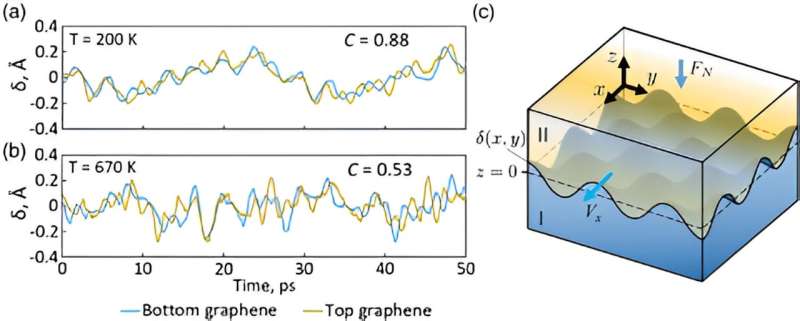This article has been reviewed according to Science X's editorial process and policies. Editors have highlighted the following attributes while ensuring the content's credibility:
fact-checked
peer-reviewed publication
trusted source
proofread
Scientists resolve intriguing phenomenon of superlubricity and formulate its laws

Skoltech researchers have explained why very weak friction obeys different laws than those governing regular friction as we know it from school physics. Among other unexpected and counterintuitive features, the alternative friction laws formulated by the team reveal why increasing the weight of a body sliding along a surface does not necessarily cause greater friction.
Understanding how friction works at the microscopic level could pave the way for controlling and exploiting ultralow friction in numerous mechanisms that would save enormous amounts of energy worldwide. The researchers report their findings in Physical Review Letters.
To some extent, everyone has an intuitive sense of the so-called Amontons-Coulomb friction law, whose manifestations we routinely observe in everyday life. Formulated more than 300 years ago, it says that friction, arising, for example, when you drag a heavy body across the ground, increases with the weight of the body. The two values—the force of friction and the body's weight—are said to be directly proportional to one another.
"Surprisingly, this law does not hold for superlubricity, the case of extremely low friction," says Skoltech Professor Nikolay Brilliantov, the principal investigator of the study.
"Superlubric friction, which is orders of magnitude smaller than conventional friction, does not depend on the body's weight, to put it in simple terms. You may increase the weight of the body thousands of times—say, from a kilogram to a few tons—but the friction will not change, remaining as small as for 1 kilogram. This phenomenon is really intriguing and calls for an explanation."
There are a couple of other surprising features of superlubricity, such as the unusual dependence of the friction force on sliding velocity, temperature, and contact area—all this runs counter to the conventional Amontons-Coulomb laws.
A team of researchers from Skoltech led by Brilliantov has resolved the enigma of superlubricity. They carried out a complex study, with experiments conducted by the group of Professor Albert Nasibulin, numerical simulations run by Research Scientist Alexey Tsukanov from Brilliantov's group, and the theoretical conceptualization of the phenomenon furnished by Brilliantov himself.
The team explained the atomistic mechanism behind the puzzling independence of the friction force from the sliding body's weight (from the "normal load," in scientific terms) and formulated alternative friction laws for superlubricity. They describe the phenomenon well but contrast sharply with the Amontons-Coulomb laws.
In simple terms, the puzzling effects may be explained as follows. Superlubricity is associated with surfaces that are very smooth, down to the atomic level—like the surface of the carbon-based material graphene. Moreover, the contact of the two surfaces should be incommensurate. That means the atomic-level roughness (also called corrugation) of the two surfaces should not be mutually coherent.
In other words, the potential "hills" of one surface should not fit into the potential "wells" of the other. If the "hills" and "wells" fit, the two surfaces lock together, and a considerable force is needed to make them slide. Incommensurate surfaces, on the other hand, do not lock, and therefore slide easily.
Still, friction may arise due to thermal fluctuations. The out-of-plane fluctuations of the surfaces at contact noticeably increase their atomic-level roughness, which hinders the relative motion of the two surfaces.
The Skoltech researchers demonstrated, however, that not all thermal fluctuations are important—only those that are in sync, when the two surfaces bend simultaneously, while remaining in tight contact. Such fluctuations require minimal energy and do not depend on the normal load, i.e., the weight of the sliding body. This explains why friction is independent of the weight. Moreover, the relative sliding of the surfaces drives these synchronous fluctuations—the "surface wrinkles"—in the direction of motion with the sliding velocity.
Such driving requires energy, which dissipates in the bulk of the material as heat, resulting in a dissipative friction force proportional to the velocity.
The larger the temperature of the surfaces, the larger the amplitude of the synchronous fluctuations. The greater the contact area, the larger the number of surface fluctuations that hinder relative motion. Quantitative analysis of these effects yields the respective laws of superlubricity reported in the paper.
More information: Nikolay V. Brilliantov et al, Atomistic Mechanism of Friction-Force Independence on the Normal Load and Other Friction Laws for Dynamic Structural Superlubricity, Physical Review Letters (2023). DOI: 10.1103/PhysRevLett.131.266201
Journal information: Physical Review Letters
Provided by Skolkovo Institute of Science and Technology





















